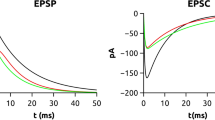Abstract
Acidic amino acids such as glutamate are widely accepted to be excitatory neurotransmitters throughout the cns. Although it remains difficult to identify the transmitter released at central synapses, the receptor types mediating synaptic responses can be identified with more certainty. Excitatory amino acid (EAA) receptors can be classified broadly as NMDA (N-methyl-D-aspartate) and non-NMDA receptors, on the basis of the sensitivity of responses mediated by them to selective agonists and antagonists. It is probable that non-NMDA receptors constitute several distinct receptor types, but no definitive classification has yet emerged that satisfies all the available data. It is however likely that EAA receptors of the non-NMDA type(s) mediate a large proportion of fast synaptic transmission throughout the cns. EAAs have been the subject of many books and review articles in recent years some of which are listed with the references. This article therefore covers some fundamental points and more recent advances.
Preview
Unable to display preview. Download preview PDF.
Similar content being viewed by others
References
Bindman, L.J. and Murphy, K.P.S.J. (1988). NMDA—receptors participate in the maintenance of long—term potentiation of synaptic transmission in slices of rat neocortex in vitro J. Physiol. 406 176P.
Cavalheiro, E.A., Lehman, J. and Turski, L. (1988). Frontiers In Excitatory Amino Acid Research. Alan R. Liss. New York.
Eaton, S.A. and Salt, T.E. (1989). Synaptic responses to noxious physiological stimulation in the thalamus of the anaesthetized rat are not antagonized by the non—NMDA receptor antagonist, CNQX. J. Physiol. (in the press).
Forsythe, I.D. & Westbrook, L. (1988). Slow excitatory postsynaptic currents mediated by N—methyl—D—aspartate receptors on cultured mouse central neurones. J. Physiol. 396 515–533.
Headley, P.M., Parsons, C.G. and West, D.C. (1987). The role of N-methylaspartate receptors in mediating responses of rat and cat spinal neurones to defined sensory stimuli. J. Physiol. 385 169–188.
Johnson, J.W. and Ascher, P. (1987). Glycine potentiates the NMDA response in cultured mouse brain neurones. Nature 325 529–531.
Kessler, M., Baudry, M., Terramani, T., and Lynch, G. (1987). Complex interactions between a glycine site and NMDA receptors. Soc. Neurosci Abs 13 760.
Kleinschmidt, A., Bear, M.F. and Singer, W. (1987). Blockade of “NMDA” receptors disrupts experience—dependent plasticity of kitten striate cortex. Science 238 355–358.
Mayer, M.L. and Westbrook, G.L. (1984). Voltage-dependant block by Mg++ of NMDA responses in spinal cord neurones. Nature 309 261–264.
Monaghan, D.T., Olverman, H.J., Nguyen, L., Watkins, J.C. Cotman, C.W. (1988). Two classes of N—methyl—D—aspartate recognition sites: Differential distribution and differential regulation by glycine. Proc. Natl. Acad. Sci. USA. 85 9836–9840.
Morris, R.G.M., Anderson, E., Lynch, G.S. and Baudry, M. (1986). Selective impairment of learning and blockade of long—term potentiation by an N—methyl—D—aspartate receptor antagonist, AP5. Nature 319 774–776.
Murphy, P.C., Salt, T.E. and Sillito, A.M. (1989). Contribution of both NMDA and non—NMDA receptors to transmission of the visual input to X and Y cells in the feline dorsal lateral geniculate nucleus (dLGN). J. Physiol, (in the press).
Nowak, L., Bregestovski, P., Ascher, P., Herbert, A., Prochiantz, A. (1984) Magnesium gates glutamate—activated channels in mouse central neurones. Nature 307 462–464.
Ransom, R.W. and Stec, N.L. (1988). Cooperative modulation of [3H]MK-801[MK801] binding to the N—methyl—D—aspartate receptor—ion channel complex by L—glutamate, glycine, and polyamines. J. Neurochem. 51 830–836.
Salt, T.E. (1986). Mediation of thalamic sensory input by both NMDA receptors and non—NMDA receptors. Nature 322 263–265.
Salt, T.E. (1987). Excitatory amino acid receptors and synaptic transmission in the rat ventrobasal thalamus. J. Physiol. 391 499–510.
Salt, T.E. (1989). Modulation of NMDA receptor—mediated responses by glycine and D—serine in the rat thalamus in vivo. Brain Res. 481 403–406.
Thomson, A.M. (1986). A magnesium-sensitive post-synaptic potential in rat cerebral cortex resembles neuronal responses to N-methylaspartate. J. Physiol. 370 531–549.
Thomson, A.M., Girdlestone, D. and West, D.C. (1988). Voltage-dependent currents prolong single-axon postsynaptic potentials in layer III pyramidal neurons in rat neocortical slices. J. Neurophysiol. 60 1896–1907.
Thomson, A.M., Girdlestone, D. and West, D.C. (1989a). A local circuit neocortical synapse that operates via both NMDA and non-NMDA receptors. Br.J.Pharmac. 96 406–408.
Thomson, A.M., Walker, V.E. and Flynn, D.M. (1989b). Glycine enhances NMDA-receptor mediated synaptic potentials in neocortical slices. Nature 338 422–424.
Thomson, A.M. (1989) Glycine modulation of the NMDA receptor/ channel complex. TINS 12 349–353.
TINS. (1987). Excitatory amino acids in the brain — focus on NMDA receptors. TINS 10 263–302.
Turski, W.A., Gramsbergen, J.B.P., Traitler, H. and Schwarcz, R. (1989). Rat brain slices produce and liberate kynurenic acid upon exposure to L-kynurenine. J. Neurochem. (in the press).
Editor information
Editors and Affiliations
Copyright information
© 1991 Macmillan Publishers Limited
About this chapter
Cite this chapter
Thomson, A.M. (1991). Excitatory Amino Acid Receptor Mediated Synaptic Transmission in the Somatosensory System. In: Franzén, O., Westman, J. (eds) Information Processing in the Somatosensory System. Wenner-Gren Center International Symposium Series. Palgrave, London. https://doi.org/10.1007/978-1-349-11597-6_10
Download citation
DOI: https://doi.org/10.1007/978-1-349-11597-6_10
Publisher Name: Palgrave, London
Print ISBN: 978-1-349-11599-0
Online ISBN: 978-1-349-11597-6
eBook Packages: EngineeringEngineering (R0)




